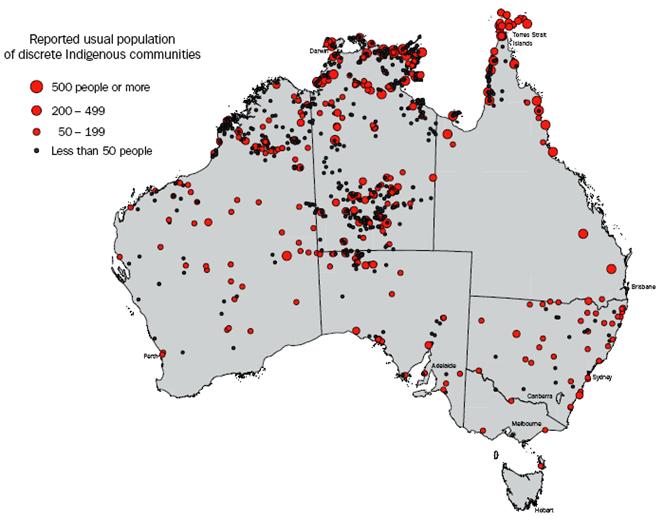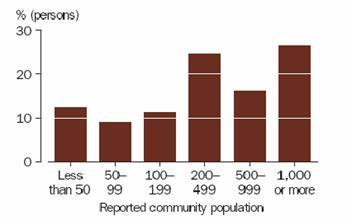Chapter 2
Setting the scene
Scope
2.1
Given the wide scope of its terms of reference the committee has aimed,
in its first report, to provide a survey of the breadth of issues that have
been raised with it so far and to provide some direction for the focus of
future reports over the course of its inquiry to 2010.
Distribution and composition of the Indigenous population
Australia's Indigenous population
2.2
As noted in Chapter 1 this report uses the most widely accepted definition
of remoteness—the Accessibility/Remoteness Index of Australia (ARIA+). After
the 2006 census, the Australian Bureau of Statistics (ABS) estimates the
Indigenous population of Australia as at 30 June 2006 to be 517 000 people, or 2.5 per cent of the total Australian population. In terms of absolute
numbers, New South Wales and Queensland have the highest number of Indigenous
residents, with 148 200 and 146 400 respectively. Western Australia has an
Indigenous population of 77 900 and the Northern Territory 66 600.[1]
2.3
The committee notes that although major cities are home to the largest
single proportion of Indigenous people, a comparatively higher proportion of
Indigenous people live in regional and remote areas of Australia. In 2006, an
estimated 43 per cent of the Indigenous population were living in regional
areas and an additional 25 per cent in remote areas,[2]
thus the scope of the committee's inquiry covers almost 70 per cent of the
Indigenous population.
Location of Indigenous communities
2.4
According to ABS data, in 2006 almost one-fifth, or 93 000 of Australia’s
estimated 517 000 Aboriginal people and Torres Strait Islanders lived in a
discrete Indigenous community. The term 'discrete Indigenous community' refers
to a geographic location that is bounded by physical or legal boundaries, is
inhabited or intended to be inhabited predominantly by Indigenous people, and
with housing or infrastructure managed on a community basis.[3]
2.5
As can be seen from Figure 1 below, showing discrete Indigenous
communities by remoteness, the majority of discrete Indigenous communities,
approximately 85 per cent, are located in remote or very remote locations. The
remaining 15 per cent of discrete Indigenous communities are located in either major
cities or the inner/outer regional areas, in communities such as Redfern in Sydney
and Framlingham in western Victoria.[4]
Fig. 1 – Discrete Indigenous communities and
remoteness locations

|
Source: Australian Bureau of Statistics,
Housing and Infrastructure in Aboriginal
and Torres Strait Islander Communities, Australia, 2006 (Cat. 4710.0)
(ABS
data used with permission from the Australian Bureau of Statistics) |
|
2.6
There is also a great diversity in the distribution of Indigenous
communities between the states and territories. The Northern Territory has the
highest proportion of Indigenous people living in discrete communities, approximately
45 per cent, with 81 per cent of its Indigenous population living in remote or
very remote areas. In Western Australia 15 per cent of Indigenous people live
in discrete communities with 41 per cent living in remote or very remote areas.
In contrast, in states like South Australia, Victoria and New South Wales
almost half of the Indigenous population live in major cities.[5]
2.7
John Taylor states:
Reference
to remote Australia draws attention to the vast two-thirds of the
continent where economic development and access to goods and services are
severely impeded by small numbers and long distances. Fully one-quarter of the Indigenous
population lives scattered across this landscape in places that are either
close to, or on, lands they have owned via descent or other kin-based
succession for millennia. Overall Indigenous people account for almost half of
the resident population of very remote Australia; although away from the main
service and mining towns dotted across this vast area, they are by far the
majority...this means that Indigenous people and their institutions predominate
over the bulk of the continental land mass.[6]
2.8
The committee notes that although the ABS data is the most comprehensive
statistical analysis of the Indigenous population, according to the Australian National
University's Centre for Aboriginal Economic Policy Research (CAEPR), there has
been a substantial undercounting of the Indigenous population in the 2006
Census. CAEPR estimates this undercount to be around 11.5 per cent nationally,
but of greater interest to the committee is that the extent of the undercount
is most significant in Western Australia (with a projected 24 per cent
undercount) and the Northern Territory (with a projected undercount of 19 per
cent).[7]
Size of Indigenous communities
2.9
ABS data indicates that out of 1 187 discrete Indigenous communities a
total of 865 communities, or 73 per cent, reported a usual population of less
than 50. Of these 1 187 discrete remote communities 17 had a population of 1 000
or more.[8]
This is depicted over the page in Figure 2.
Figure 2 – Population distribution and location by
size of community

|
Source: Australian Bureau of Statistics,
Housing and Infrastructure in Aboriginal
and Torres Strait Islander Communities, Australia, 2006 (Cat. 4710.0)
(ABS
data used with permission from the Australian Bureau of Statistics) |
|
2.10
In 2006, 26 per cent of people in remote Indigenous communities lived in
one of the fourteen communities with 1 000 or more people such as Yuendumu in
the Northern Territory and Hope Vale in Queensland. A further 41 per cent of
people living in discrete Indigenous communities lived in communities with
between 200 and 1 000 residents and 20 per cent were in communities with
between 50 and 199 residents. Nearly 13 per cent of people lived in communities
with a population of less than 50 people.[9] See figure 3 over
the page.
Figure 3 – Population distribution, remote
communities, by size of community – 2006.

|
Source: 'Housing and
Services in Remote Aboriginal and Torres Strait
Islander Communities', Australian Social Trends, 2008 (cat. 4102.0)
(ABS
data used with permission from the Australian Bureau of Statistic)
|
|
2.11
The size and geographic location of Indigenous communities has an
obvious relevance for policy makers when contemplating service delivery to
Indigenous people in regional and remote communities. However there are other
factors that impact on service delivery and Indigenous community wellbeing. It
is well known that the Indigenous population is relatively youthful in
comparison to the non-Indigenous population. Research indicates that this is
due to a combination of higher fertility rates as well as higher mortality
rates. While much of the non-Indigenous Australian population contemplates how
to fund their retirement, many Indigenous people are unlikely to reach retirement
age. The needs and concerns of Indigenous people are therefore focused at the
other end of the social policy spectrum—on raising families, child health,
education, criminal justice, family housing, and jobs.[10]
2.12
Another factor relevant to regional and remote Indigenous communities is
the rate at which Indigenous people move between their home and other
communities. While on average Indigenous residential relocation rates are the
same as the rates for the non-Indigenous population, Indigenous people relocate
far more often in and around major cities but far less often in remote areas.
In remote areas Indigenous people are far more likely to move temporarily
between communities within a region, with high rates of travel within the
region for relatively short periods of time.[11]
Range of issues and emerging themes
2.13
As discussed in Chapter 1, the committee notes the breadth and depth of
issues raised with it both in submissions and during its inspection visit in
the Kimberley region of Western Australia. These issues are discussed in detail
under chapters 2-6 under each term of reference. While many of the issues are
complex and will require further consideration during the committee's inquiry
to 2010, the following themes have emerged during the inquiry process thus far:
- A perceived need for a greater investment in people, resources and
infrastructure to meet the needs and aspirations of regional and remote communities;
- A commitment from state and territory and Commonwealth
governments to long term relationships and partnerships with Indigenous people
and communities as way of solving entrenched problems;
- Ability of government programs to be tailored to the needs and
strengths of communities, not the other way around;
- Increased accountability of bureaucracies to Indigenous people
and communities; and
- A perceived lack of awareness of the serious nature of the issues
confronting people living in regional and remote Indigenous communities.
2.14
The committee considers that it has an important role in bringing these
issues to the attention of not only the Senate but also to increasing awareness
amongst the Australian public more generally.
Navigation: Previous Page | Contents | Next Page